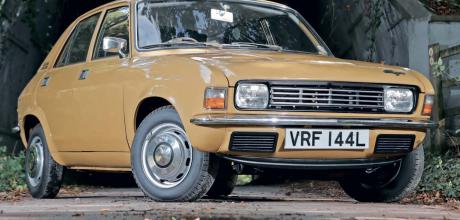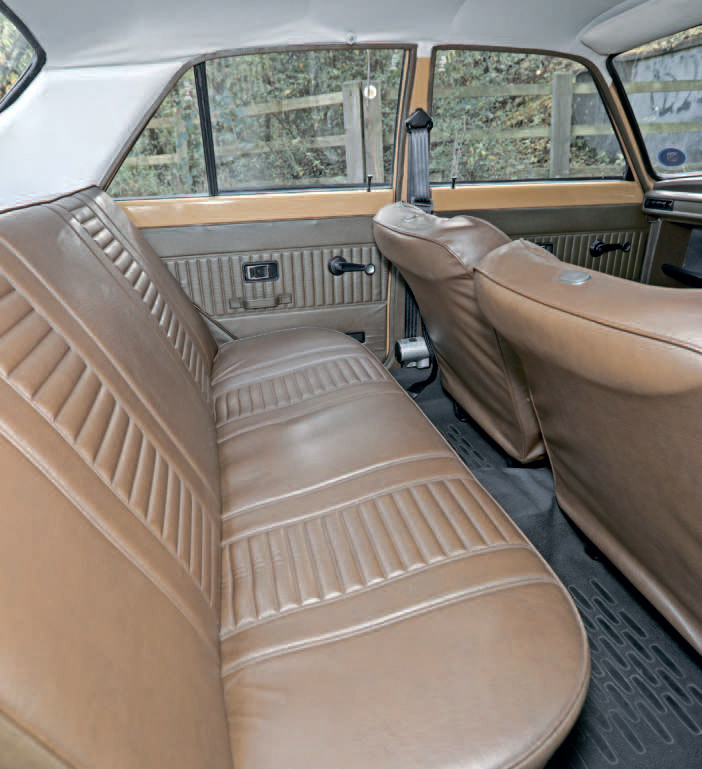1973 Austin Allegro 1300 Deluxe
The Allegro is the ultimate anti-style statement – which pleases Colin Corke greatly. Words and pictures: Richard Dredge.
AUSTIN ALLEGRO: early survivor of a BL legend restored
Within two minutes of starting my chat with The Reverend Colin Corke about the restoration of his Allegro, I know the resulting feature will be rather more wide-ranging than one of mere revival of arguably BL’s most reviled family car. The effervescent Colin is brimming over with anecdotes and enthusiasm; it’s immediately clear that he’s an anorak of the highest order...
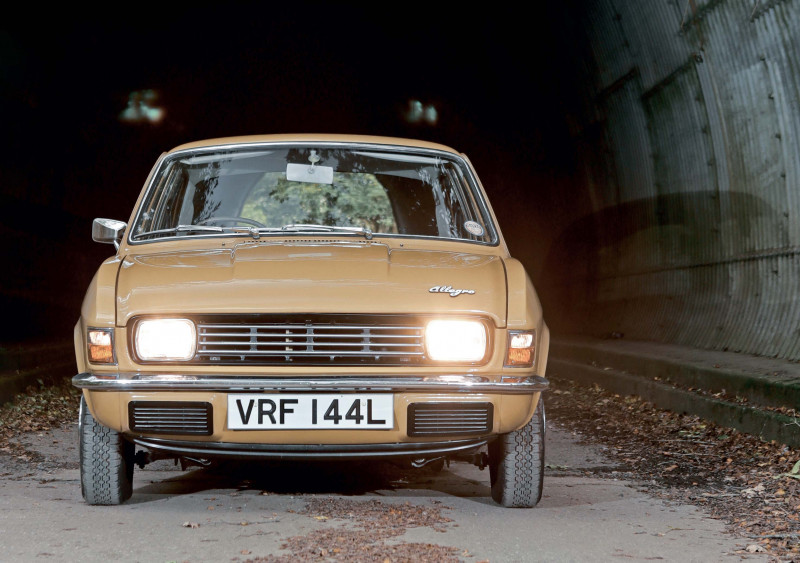
Colin has been the vicar of Longbridge since 2001, and since then he’s done a fabulous job of flying the flag for BMC, BL, Austin Rover and MG Rover, and the Allegro in particular, as chairman of the Allegro Club International. It’s a group that came about pretty much by accident more than three decades ago.
“I spent weeks and weeks cleaning up the bodyshell and before I knew it a year had passed. VRF’s bodyshell was a lot rustier than I’d thought, and being such an early car it deserved a really high-quality restoration, so the goalposts shifted somewhat.”
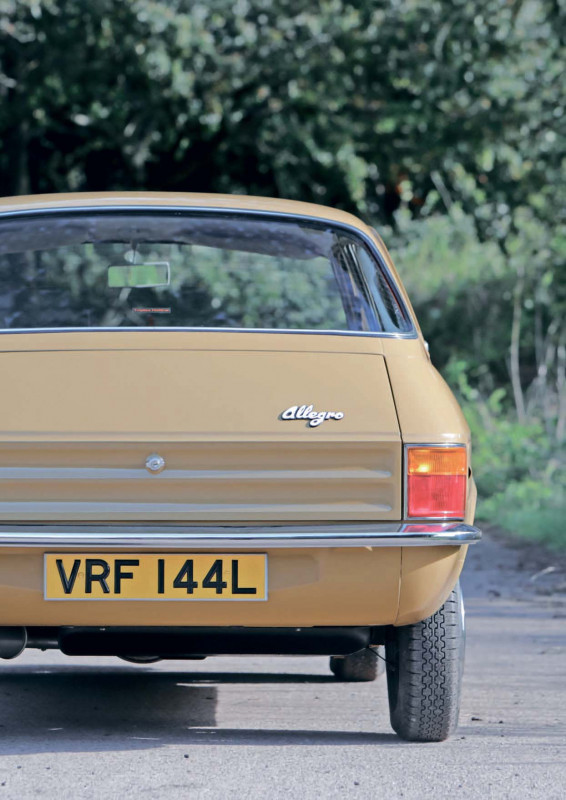
“This chap called me about his dad’s L-reg Allegro, which he had bought new. That first owner was Albert Bloor who ordered the Allegro on the day the model was launched, 17 May 1973.”
Colin comments: “In 1989, someone wrote a spoof letter to the long-defunct Your Classic, making out that there was an Allegro owners’ club, which seemed like a ridiculous notion. But Allegro owners Tony and Lynne Marshall reckoned that it wasn’t a stupid idea at all, and to prove it they set up Allegro Club International (ACI) in 1990. I was appointed historian, even though I wasn’t a member, but I soon signed up, and I’ve been the club’s chairman three times over the years. When the group was founded Allegros were plentiful, but not any more. Within our ranks there are about 300 owners, many of whom have more than one car, but in the mid-nineties our membership peaked at almost 1000. Since then, a lot of Allegros have bitten the dust.
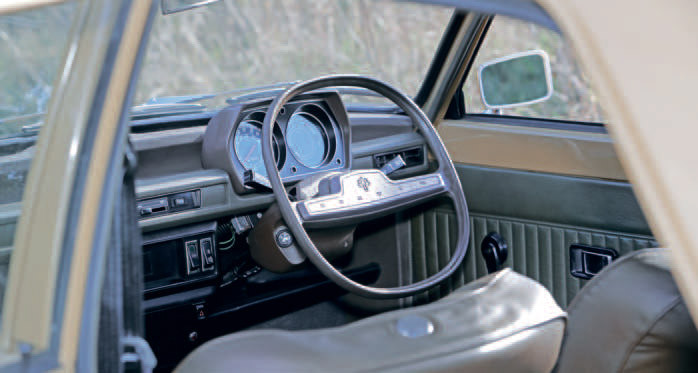
“The Allegro was launched when I was 14, and in those days I spent my pocket money on Autocar, which I read from cover to cover. I remember guiding my teachers through the vagaries of the car market, advising them on what to buy; a friend’s dad bought a Volvo 164 because I told him to, and he loved it so much that he followed it up with another. I’ve been obsessed with cars since I was in a pram. As soon as I could speak I would ask my mum what the different cars were.”
Most car obsessives are hooked early because their parents drag them along to race meetings, or there are constant engine or gearbox rebuilds being undertaken in the family garage. But it wasn’t like that in the Corke household; Colin’s father didn’t even drive until years after Colin passed his driving test. Growing up in the middle of nowhere, a ride in a car was an occasion, with the Corke clan reliant on buses to get them from their village to civilisation.
Colin continues: “I didn’t love the Allegro when it was launched, but I’ve always been fascinated by its reputation. In the seventies one of our neighbours had an Allegro and it was a disaster, and while ADO16 was a tough act to follow, was the Allegro really that bad? The dealers were certainly keen to have something new to sell, and the car wasn’t initially seen as naff in any way. But the media were quick to condemn the Allegro and that didn’t help. Motor ran an early 1750 SS for a while without any problems, but Autocar’s Allegro needed an engine rebuild and it suffered terribly from water leaks. Those were endemic unfortunately; in 1974 a service bulletin was issued to dealers telling them to drill holes in the boot floor. They couldn’t stop the boot from filling up with water so they just had to do their best to let it drain out.
“Towards the end of 1981, I graduated in Theology and started a new job at London-based BL dealer Kenning (London) Limited, the former Car Mart Austin franchise. The Acclaim was launched as I arrived and the Allegro 3 was in the price list. On the demonstrator fleet was a twin-carb Allegro 3 1.5L which I used to drive rather a lot. It was fast, refined and economical, and while it wasn’t brilliant it was perfectly adequate. Even the press were forced to admit that the Allegro 3 was alright. It should have been; by this point BL had almost a decade to get it right. I remember a three-year old Fiat 127 on the Kennings forecourt and it was already ravaged with corrosion; the Allegros of this era were far better rustproofed.”
At this point the interview veers into Confessions of a Car Salesman territory, Colin telling me about his colleague who couldn’t get the hang of his Acclaim Triomatic, so clocked up all of his urban miles in overdrive. Another salesman used to commandeer the Kennings showroom in the evenings for ‘gentlemen’s’ film nights. Colin had graduated from Oxford and a colleague was ex-Gordonstoun, and there they were selling Metros and Maestros to the great unwashed. Talk about over-qualified.
Britain was in recession when Colin joined Kennings, but that didn’t stop him from selling plenty of cars, his enthusiasm for the product no doubt being all too obvious. As a soon-to-be man of the cloth (Colin was by then set to join the clergy) no doubt he was also disarmingly honest for a car salesman. During his two years in the motor trade Colin sold the last of the TR7s, MGBs, Spitfires, Maxis and Princesses – as well as the final Allegros.
By 1983, Colin had left Kennings to attend theological college in Durham, and unable to find an Allegro of his own, he settled for a Beetle. A Citröen Visa followed, the ownership experience marred by part-time electrics, and then in 1985 came the first Allegro of many. A 1.3 HLS with just 10,000 miles on the clock and finished in seventies-tastic vermillion, provided reliable transport for the next two years and 40,000 miles before it was sold on.
A succession of Golfs and Maestros passed through Colin’s hands, but when the ACI was set up in 1990 Colin was Allegroless; cue a shopping spree which netted him a Vanden Plas 1.5, which definitely wasn’t really an Allegro, honest. By 1994 Colin also owned a brace of 1750 SSs, the Holy Grail for Allegro fans, and then he received a call from Derbyshire, about a down-at-heel early 1300 De Luxe. How could he resist?
Colin continues: “This chap called me about his dad’s L-reg Allegro, which he had bought new. That first owner was Albert Bloor who ordered the Allegro on the day the model was launched, 17 May 1973. Albert had recently retired and traded in his 1967 MG 1100 for the Allegro for which he paid £1138.50, including 10% VAT, plus £25 for road tax. He was given a trade-in of £186.80 for the 1100, and perhaps influenced by the 1100’s tendency to rust he paid £13.20 extra for underseal, even though all Allegros were undersealed from the factory.”
Colin’s first impressions were not good. There was lots of filler and overspray, bent bumpers and tatty hubcaps, and quickly realising that it wasn’t for him, he prepared to leave, promising to try to sell the car through the club. Then came the fateful invitation to drive the car, which Colin accepted so that he could report more fully to anyone interested in the car. VRF 144L duly trundled round the block leaving Colin very impressed; it drove superbly, encouraging him to buy it to sell it on.
Adverts in ACI magazine Quartic elicited no interest from anyone, so Colin tidied up VRF in a bid to find a buyer at the Allegro’s 21st anniversary celebrations at Gaydon. Colin’s new acquisition still looked scruffy, but it was the oldest Allegro at the event (and wearing chassis #6852 it’s still one of the earliest known survivors), and it had retained a raft of features unique to only the earliest Allegros, such as a drain plug on the petrol tank, a two-piece hazard flasher switch, external bonnet release, and one-piece rubber mats. When Colin’s mechanic mate and fellow club member Nick Bonthrone drove the car he realised that despite its appearance, VRF was quite a find and it was just the thing for a big tour that the ACI was about to embark upon.
Colin explains: “In 1977, BL sent 13 Allegros on a 13-day 4600-mile marathon. The cars drove round the entire coastline of Britain; Graham Robson worked out the route and along the way the Allegros, all painted in the new colour Oyster Gold, and fitted with a Webasto sunroof, called in at dealerships as part of the promotion.
“To raise funds for the Alzheimer’s Disease Society and the Cystic Fibrosis Trust, and to mark 21 years of the Allegro, in 1994 the ACI did a re-run of the Round Britain Marathon, with four cars setting off from Longbridge in the July. One owner had to drop out, but three cars finished, including VRF. Our route took us to the east coast and Suffolk, then down through Essex and Kent before driving along the south coast, around the Cornish coastline, right round the edge of Wales, across the top of Scotland then down the east coast of Scotland and England to get back to Longbridge.”
VRF despatched the marathon without a hitch, but it was clear that it was never going to pass another MoT, so Colin and Nick Bonthrone banked on fitting some fresh sills, a set of used doors, some new wings plus a front panel, before repainting the entire car. It would be a budget rebuild with costs carefully controlled. Well that was the original plan… Colin recounts: “In May 1994, my ACI friends Paul Vincent and Paul Foster called in to help me strip down VRF, and in less than half a day it was a rolling shell, looking rather the worse for wear. I was living in a village in Surrey, which was also the base for a bodyshop run by the brilliantly named Johnny Panther, whose father John came out of retirement just to paint my car. He and I agreed a price to sort out the bodywork, although he confessed that he could not finish the car to the original BL standard because he couldn’t spray that badly! The inside of the boot had never been painted properly, and it was frightening how quickly thinners removed what paint there was from the door shuts.”
Work proceeded apace, with the outer wings and sills soon removed. The inner wings were rather rustier than expected, as were the backs of the sills near the rear wheelarches. If the restoration had been put off any longer, the corrosion could have been terminal. The project then stalled for a bit as more pressing projects came in, but in a bid to keep things on the boil Colin regularly clocked up hours on end using the workshop’s equipment to remove all of the old underseal from the underside of the bodyshell.
Colin continues: “I had been starting to amass parts for VRF’s rebuild, but the second-hand doors that I purchased turned out to be accident damaged and repaired with filler, leaving me with no choice but to fit the brand new doors that I had reserved for the rebuild of an Allegro 1750 SS which I was also aiming to bring back from the dead. I spent weeks and weeks cleaning up the bodyshell and before I knew it a year had passed. VRF’s bodyshell was a lot rustier than I’d thought, and being such an early car it deserved a really high-quality restoration, so the goalposts shifted somewhat.”
A whole bedroom at the rectory was given over to the parts removed from VRF, and those obtained for the rebuild. Three second-hand Series 1 bonnets were acquired before one was good enough for the car; S1 bonnets have different internal pressings from the later ones. Parts for the underside of the Allegro were purchased or renovated, and something that proved to be a real find was a new plastic insert for the original brown Quartic steering wheel, which at the time was available new from Rover.
Colin’s dismembered Allegro sat on axle stands in Johnny’s workshop for the thick end of two years. Most of 1996 was spent removing underseal, treating rust and replacing panels wholesale, and by the end of that year the bodyshell had a fresh coat of paint far better than anything it had previously worn. But there was still a long way to go, with Johnny having to make all of the replacement panels fit. Colin stuck with genuine parts but nothing fitted properly, so everything had to be fettled.
Colin adds: “I’ve always been a fan of keeping things as original as possible, hence Johnny’s comment about not being able to apply paint that badly. When it came to applying the new paint I stuck with celllulose to keep it looking period, and to make touching in easier if necessary. While I’m not a fan of Harvest Gold, I chose to stick with VRF’s original colour.
“By January 1997 the Allegro had travelled the few hundred yards from Johnny’s workshop to my garage and it was all systems go to build the car back up again. Nick Bonthrone visited regularly to help me put the car back together and it was at this point that the bills started to mount rather quickly, with fresh parts constantly being fitted. The ACI’s spares service proved invaluable, with all sorts of parts snapped up from the stores, many of which were already scarce; nowadays you’d have no chance tracking them down.”
Many new old-stock parts bought at autojumbles, despite being boxed and unused, turned out to be sub-standard, most notably a brake master cylinder. Thankfully the interior was in very good condition and virtually all of it could be reused, which was just as well because finding any replacement early olive trim would have been pretty much impossible. A superb S1 (longer) boot mat was found in a scrap Allegro locally, new brakes, chrome trim and window seals were fitted, and gradually the car became more complete.
Nick and Colin beavered away over the winter of 1997-1998, with the engine and gearbox rebuilt, the former converted to unleaded-friendly with the fitment of a Maestro cylinder head. The cooling system was installed and at 10pm on a Saturday night, four years to the day since Colin bought VRF, it was running once more. Within a few days the final bits had been fitted (number plates and bumpers) to make the car ready for its first MoT in four years.
Pre-MoT checks showed that a brand new sealed beam headlight, fresh out of its box, packed in as soon as the switch was flicked. That was replaced, the wipers and tracking were set up, and VRF passed its MoT with flying colours, on virtually the 25th anniversary of it leaving the Longbridge factory. Since then the car has covered just a few thousand miles and unsurprisingly it’s in superb condition throughout, so I’m keen to round off my day with Colin by adding a few miles to the odometer.
I’d never driven an Allegro before so I was keen to see what I’d been missing. Colin and I headed out of Longbridge and into the countryside to see just how good – or bad – the Allegro is. I instantly warmed to the Allegro, which is far better than I expected. Sure it’s ordinary in the grand scheme of things, but the gearchange is sweet (albeit slightly notchy), and the engine has more lowdown grunt than any single-carb A-Series should have. No need to change down if there’s a sharp incline, just leave it in top and the Allegro won’t mind. All-round visibility is excellent, the steering is precise enough, and the softly sprung seats and Hydragas suspension conspire to produce a wonderfully comfortable ride, albeit not quite as cosseting as an ADO16. What’s not to like?
It’s easy to see the appeal of this ‘upturned bathtub, as it was nicknamed in period. Colin certainly loves them which is why alongside VRF he also owns the onlyRegent in the UK along with the oldest known surviving production Allegro, chassis #11, a 1750 SS that was probably built in December 1972 as part of the first batch of pilot cars. Now tell me that you’re not deeply jealous of Colin.
How it was done
- 1. Early Allegros had no blanking plate to protect the rear of the front inner wings; the rot here shows just how much they were needed.
- 2. The corrosion beneath the brake master cylinder, and the mix of underseal and ageing paint, encouraged Colin to take the engine bay back to bare metal. All of this was done before the new wave of professional stripping processes that we now have.
- 3. The removal of all rust from new old-stock panels ensured the durability of the restored Allegro started to become obsessional. The now almost unobtainable front inner and outer panels, were readily available back then.
- 4. A jubilant and rather grubby off-duty Vicar stands in the engine bay with confidence that the new paint would have a good foundation.
- 5. At long last the primer started to go on. Until this point the Allegro seemed to be looking worse before it got better. The excitement of this corner being turned was memorable.
- 6. Once Harvest Gold paint was applied the pleasure increased. John Panther Sr. applied cellulose to an amazing standard while sucking a rollup cigarette; A true craftsman of the old school.
- 7. With doors secured, rear subframe loosely installed and a wooden batten under the front, VRF could be moved like a wheelbarrow from Johnny Panther’s workshop.
- 8. After nearly three years the reassembly was exciting and relatively rapid. The target became the Allegro's 25th birthday bash in May 1998, where the newly rebuilt car could join the celebration.


